Vérité La Joie 2014
Vérité La Joie 2014 has been released today with a UK RRP of £300. We summarise all the key facts below:
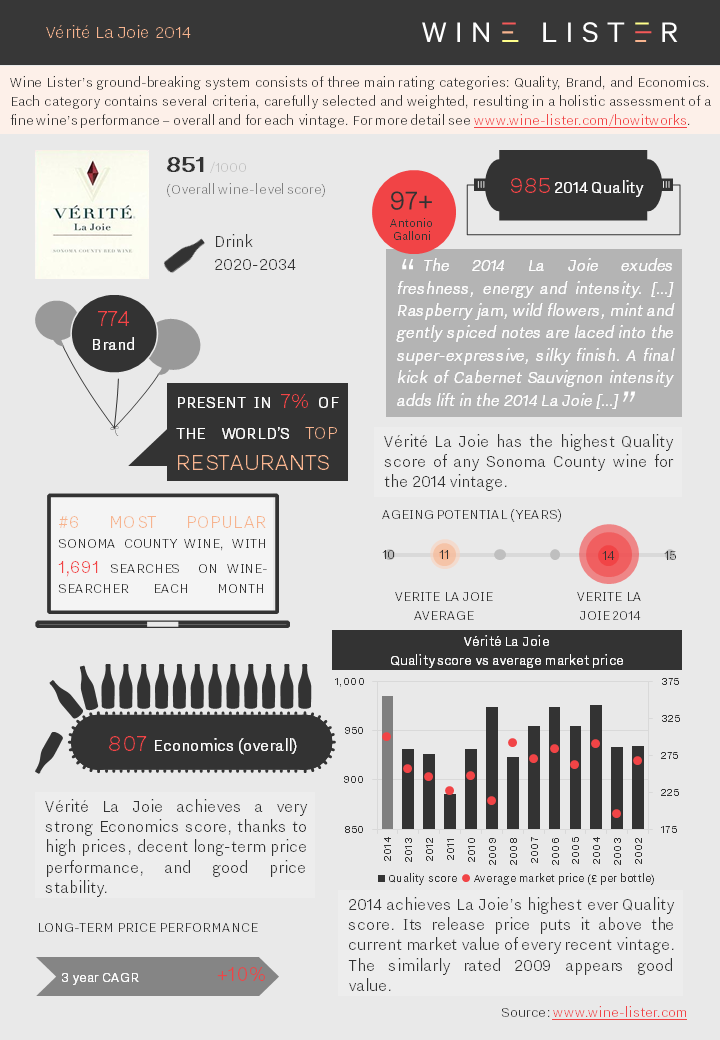
You can download the slide here: Wine Lister Factsheet Vérité La Joie 2014
Vérité La Joie 2014 has been released today with a UK RRP of £300. We summarise all the key facts below:

You can download the slide here: Wine Lister Factsheet Vérité La Joie 2014
Hommage à Jacques Perrin 2015 has been released today at £247 per bottle. We summarise all the key facts below:
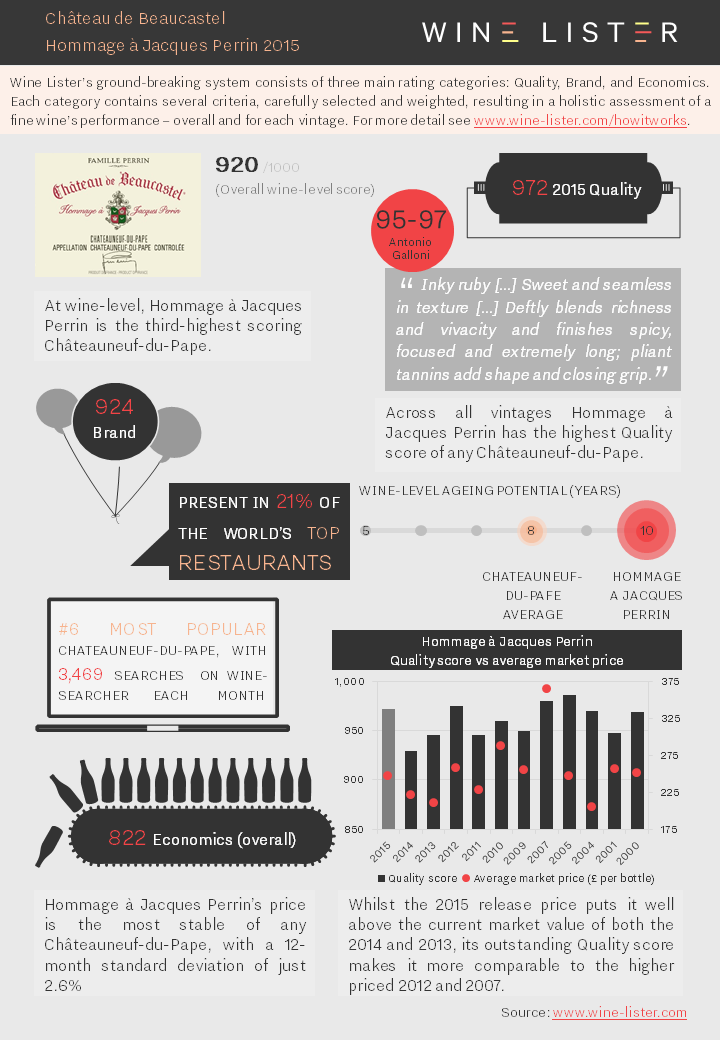
You can download the slide here: Wine Lister Factsheet Hommage à Jacques Perrin 2015
Stretching from the Atlantic coast in the West to Pouilly-sur-Loire in the East, the Loire Valley extends half way across France, and is home to some of the country’s great white wines. Reflecting the diversity of the region, the Loire’s top five whites comprise two dry Sauvignon Blancs, two sweet Chenin Blancs, and a dry Chenin Blanc. However, whilst these wines are diverse in style, they share several key characteristics – they are all produced biodynamically, in small quantities, and by cult winemakers.
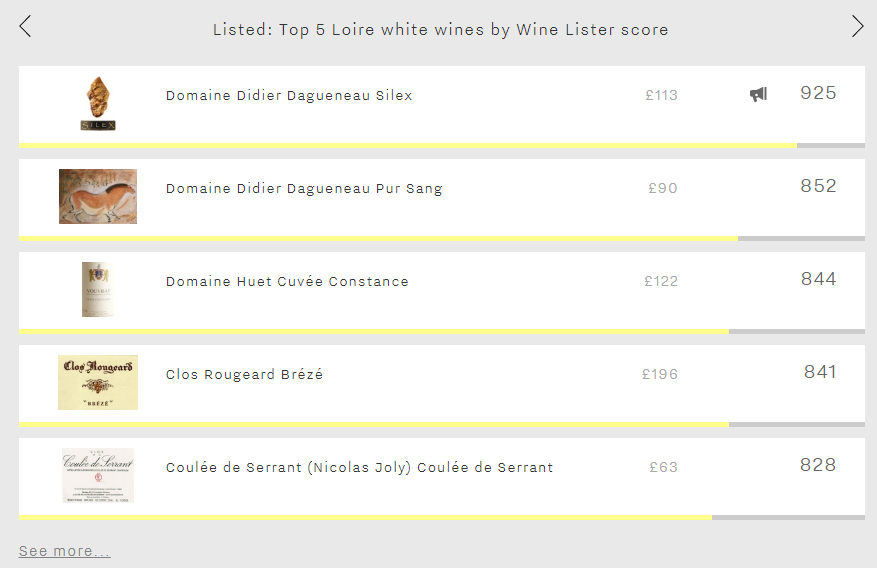
Leading the way are two Pouilly-Fumés from Domaine Didier Dagueneau – Silex and Pur Sang. One of Wine Lister’s Buzz Brands, Silex achieves excellent scores in each of Wine Lister’s three categories. However, it enjoys particularly strong brand recognition, present in 39% of the world’s best restaurants and receiving on average over 4,000 searches each month on Wine-Searcher. Pur Sang achieves its best score in the Economics category, thanks to strong price performance – with a three year CAGR of 14% and a six month growth rate of 13%.
Moving West to Vouvray, Domaine Huet Cuvée Constance comes next. Produced only in great vintages, this botrytised Chenin Blanc has the best Quality score of the group (981), and the 14th highest of all white wines on Wine Lister.
Continuing further down the valley, Clos Rougeard Brézé is in fourth place. The most expensive wine of the group, it has a remarkable three year CAGR of 33%, confirming that it is a wine on a strong upward trajectory. The fifth wine is Nicolas Joly’s Coulée de Serrant. Produced in the most westerly appellation of the group – Savennières Coulée de Serrant – Brand is its strongest category, present in 31% of top establishments.
Don’t forget – if you’re not yet a subscriber to Wine Lister, you can still fully explore this week’s five Listed wines, and those for the previous four weeks, via the homepage.
The 1855 Bordeaux classification might well be considered one of the earliest examples of a wine rating system. Classifying wines by six categories – including “unclassified” – might seem restrictive now (compared to Wine Lister’s 1,000 point scale), but the classification has proven to be highly influential and durable. This week’s Listed section focuses on the five Bordeaux fifth growths with the highest overall Wine Lister score, giving us an opportunity to see how the 160-year-old classification stacks up today.
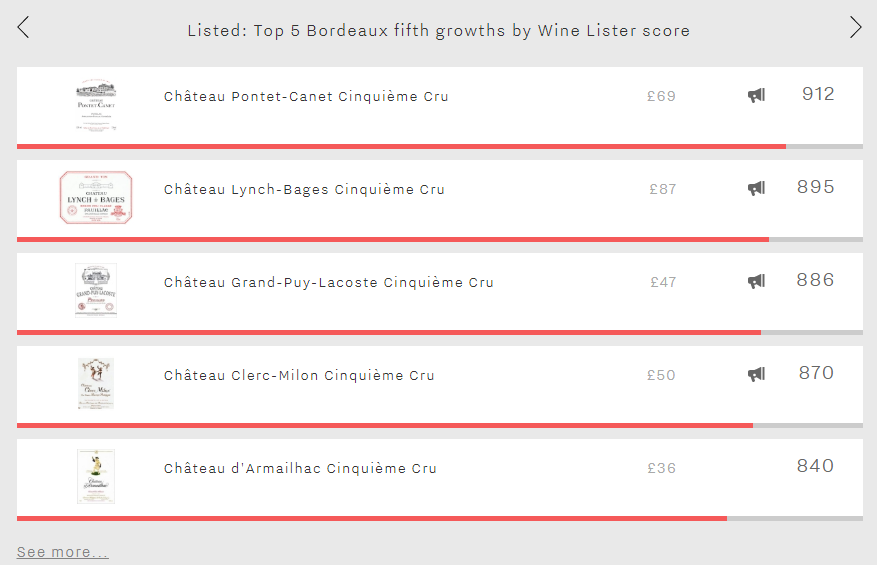
Whilst the 1855 classification used price as the yardstick by which a wine should be rated, Wine Lister’s holistic approach also takes into account quality, brand strength, and other economic metrics. The outcome is that with an average Wine Lister score of 881, these flying fifths outperform both the top five performing third growths and fourth growths (average of 863 and 834 respectively), beating the two classes across every category. Nonetheless, the top fifth growths trail the most highly-rated second growths and the five first growths by 48 and 86 points respectively overall.
Pontet-Canet is the leading fifth growth, with a score of 912. While all five wines perform well in terms of Brand score, Pontet-Canet’s first place position is supported by an excellent Quality score of 905, nearly 60 points above Grand-Puy-Lacoste, the second highest rated of the five in terms of quality.
Lynch-Bages comes next. Whilst it performs well in the Quality and Economics categories, it is in the Brand category that it comes into its own, with a near-perfect score of 998 putting it alongside first growths Haut-Brion and Margaux.
Grand-Puy-Lacoste takes third place with 886, scoring well across the board. It is one of the four Buzz Brands of the group, a fact which confirms that these top fifth growths currently confer more prestige than their third and fourth growth counterparts, which see fewer Buzz Brands within their respective top fives.
The last two spots are filled by wines from the Baron Philippe de Rothschild stable – Clerc-Milon and d’Armailhac. The former achieves the highest Economics score of the group – 908 – thanks to excellent price performance over both the long and short-term. Meanwhile, d’Armailhac’s score of 840, whilst 30 points below Clerc-Milon, puts it above all but four third and fourth growths.
These results blur the lines between the traditional classifications, demonstrating that price can no longer be looked at in isolation, and suggesting that a more nuanced and flexible approach needs to be taken in rating wines.
Remember that there are many ways to search Wine Lister, including by score, geography, and classification – which is how we calculated the findings above.
Opus One 2014 was released today at £210 per bottle. Described as a “gorgeous wine” by Wine Lister partner critic Antonio Galloni, we summarise all the key information below:
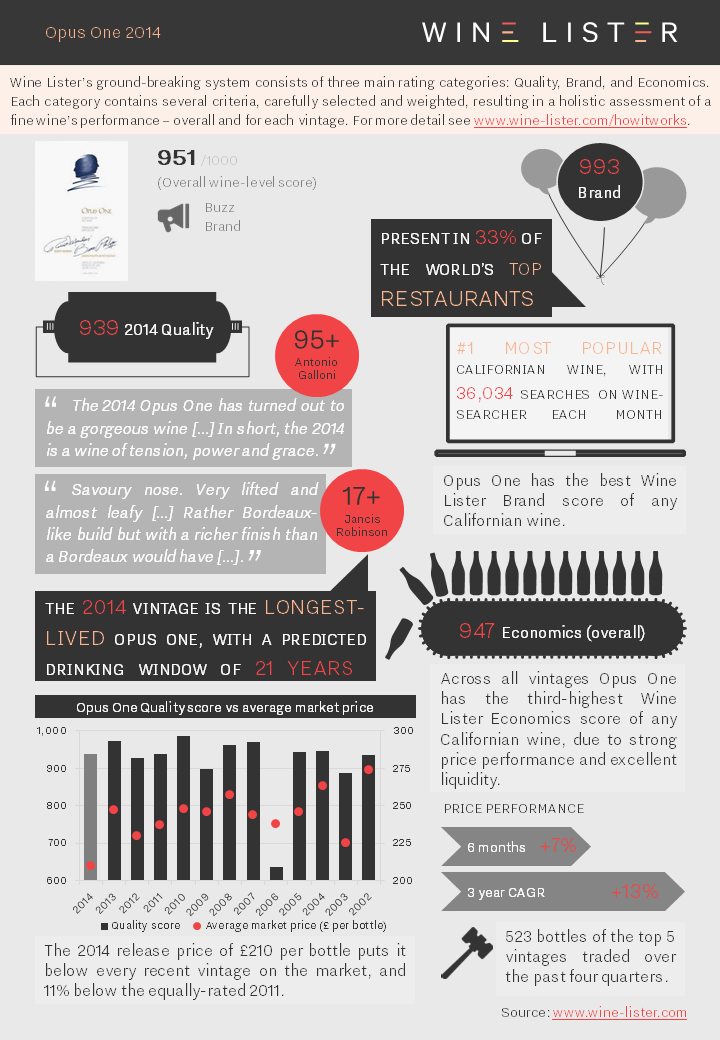
You can download the slide here: Wine Lister Factsheet Opus One 2014
One of Wine Lister’s four Indicators, Value Picks identify the wines and vintages which have the best quality to price ratio, with a proprietary weighting giving more importance to quality, thus giving the finest wines a look-in.
With the latest price data in, 28 new wines have recently qualified as Value Picks. While Value Picks are calculated using a three-month average bottle score for accuracy (in order to take into account any price fluctuations), we have shown the current price per bottle below for ease of comparison. Please note that the price shown is excluding duty and VAT, and often reflects prices available only when purchasing a full case:
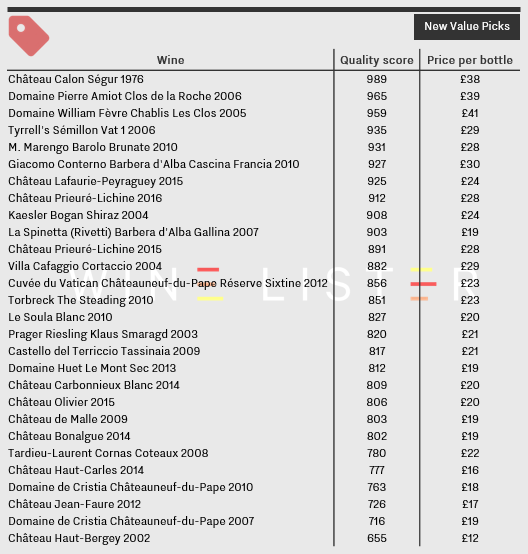
Bordeaux dominates the new Value Picks, filling 11 of the 28 spots. Margaux’s Prieuré-Lichine seems a particularly keenly-priced brand at the moment, with both its 2015 and 2016 vintages now Value Picks. With Wine Lister Quality scores of 891 and 912 respectively – very strong and amongst the strongest on Wine Lister’s 1000 point scale – and both priced under £30, they represent excellent value buys. Within Bordeaux, Pessac-Léognan is home to the highest number of new Value Picks. Of those, two are white, with Château Carbonnieux Blanc 2014 and Château Olivier 2015 achieving very similar Quality scores (809 and 806 respectively), and each priced at just £20.
The other wine to feature twice in the latest update is Domaine de Cristia Châteauneuf-du-Pape, with its 2010 and 2007 vintages. The former, which achieves a Quality score of 763, is available at just £18 per bottle. With plenty of life left in it, it looks like a great buy.
Three Piedmontese wines recently qualified as Value Picks – M. Marengo Barolo Brunate 2010, Giacomo Conterno Barbera d’Alba Cascina Francia 2010, and La Spinetta (Rivetti) Barbera d’Alba Gallina 2007. All three achieve powerful Wine Lister Quality scores of over 900 points. You might buy Giacomo Conterno’s wines to impress – the Barolo Cascina Francia is a Wine Lister Buzz Brand, but also averages £157 per bottle. If you’re looking for something more appropriate for a weeknight, the 2010 vintage of the same producer’s Barbera d’Alba, priced at just £30, would be an excellent Value Pick – a perfect example of how Wine Lister’s indicators can help you find the right wine for any situation.
Wine Lister’s four Indicators – Investment Staples, Value Picks, Hidden Gems, and Buzz Brands – were designed to enable users to find the perfect wine for any scenario in just a couple of clicks. Buzz Brands, the most talked-about wines, are sure to impress: they have strong distribution across the world’s top restaurants, show high online search frequency or a recent growth in popularity, and are identified by the fine wine trade as trending or especially prestigious.
Having recently expanded and updated Wine Lister’s restaurant presence coverage, 29 new wines now qualify as Buzz Brands, their global distribution broadening. To achieve Buzz Brand status, a wine must be among the top fifth of all wines that feature at least once on the menus of the world’s best restaurants – prized for their wine lists as well as their food.
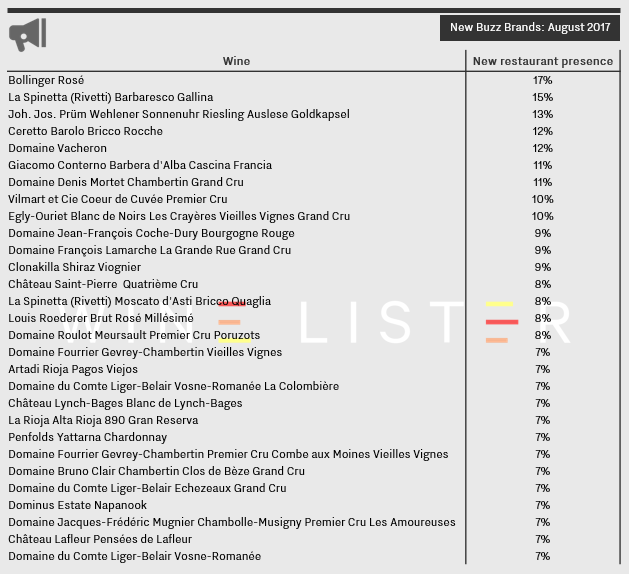
Of the 29 wines above, 11 hail from Burgundy, confirming the region’s continued demand amongst the restaurant trade. Domaine du Comte Liger-Belair fares particularly well, with three of its wines becoming new Buzz Brands, thus suggesting it is a producer on an upward trajectory. These wines also benefit from a high online search frequency, as measured by Wine-Searcher, with the wine with the highest number of searches, Domaine du Comte Liger-Belair Echezeaux Grand Cru, seeing 1,400 searches per month.
Champagne has also benefitted from the restaurant presence update, with four wines from the region gaining Buzz Brand status. Of this month’s new Buzz Brands, Bollinger Rosé now has the most impressive distribution, present in 17% of the world’s top establishments.
Piedmont sees four wines attain Buzz Brand status. Two new wines from La Spinetta now qualify as Buzz Brands, with Ceretto Barolo Bricco Rocche and Giacomo Conterno Barbera d’Alba Cascina Francia making up the quartet.
There are three new Bordeaux Buzz Brands, and one carries the accolade of being the most searched-for wine in the table. Château Saint-Pierre receives in excess of 3,700 searches per month, which in addition to appearing on 8% of the world’s very best restaurants makes it well-deserving of its new Buzz Brand status.
Wine Lister’s Economics scores are based on a variety of price and liquidity metrics, including a wine’s three-month average bottle price, six-month price performance, and three-year CAGR. This week’s newly updated Listed section features the five top-scoring Australian wines by Economics score. Noticeably, all are red, and red wines outperform for Australia in this category (the top white, Leeuwin Estate Art Series Chardonnay, has an Economics score of 498, its top traded vintages only trading 10 bottles in auction over the past year). While there is quite a difference in points between the first and fifth wine on today’s list, all are considered very strong (750–900) or among the strongest (900+) wines in Wine Lister’s database.
Several of Australia’s best-known producers feature in our top five, including Penfolds, which accounts for the top two entrants: Penfolds Grange and Penfolds Bin 707 Cabernet Sauvignon. While both wines excel on three-month average bottle price and three-year CAGR, Penfolds Grange is particularly strong for liquidity, its top five trading vintages having traded 626 bottles over the past four quarters.
The third wine on this list, Torbreck Run Rig, experiences good trading volumes but has the lowest three-year CAGR of the five (3.27%). Fourth place goes to Henschke Mount Edelstone Shiraz, which is the lowest in price and sees fewer bottles traded than the others, but has an excellent six-month price performance of 11.88% and good price stability. Finally, the list is completed by Grant Burge Meshach Shiraz, which has one of the higher three-year CAGRs, at 6.4%.
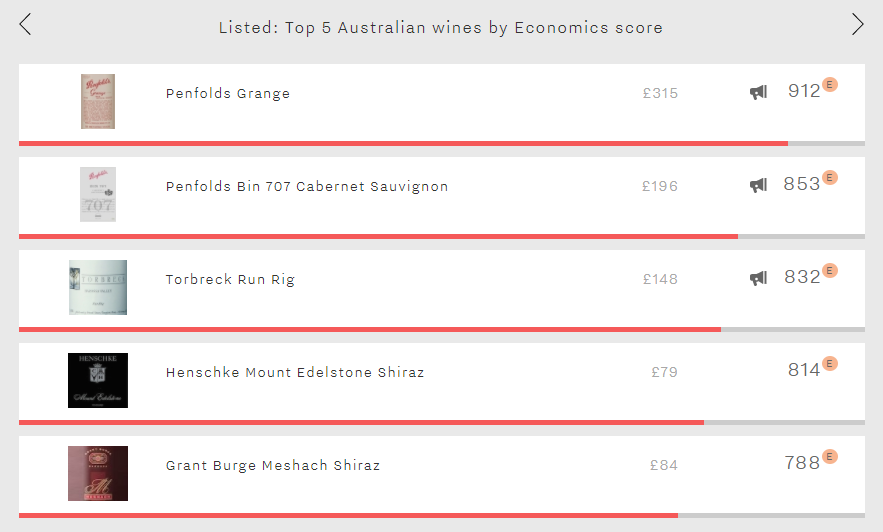
Don’t forget – if you’re not yet a subscriber to Wine Lister, you can still fully explore this week’s five Listed wines, and those for the previous four weeks, via the homepage.
As Wine Lister’s holistic rating system demonstrates, there are many factors (nine criteria, in all) to take into account when calculating a wine’s greatness. One of these is distribution in the world’s top restaurants, our measure of a wine’s prestige and clout on the international market. In order to identify the restaurants that count – not just for the food but for the wine – we have created a matrix of global restaurants with Michelin stars, 50 Best Restaurants, World of Fine Wine Best Wine List awards, and more. We take the most formidable combination of these as the basis for our painstaking analysis.
We are expanding our coverage constantly, and the latest instalment is now in. This year alone has seen an increase of 50%, to 150 restaurants analysed. New entrants come from across the globe, from New York’s Balthazar to Paris’s Carré des Feuillants.
The table below shows the 20 wines to have seen their restaurant presence increase the most since the last update in April:
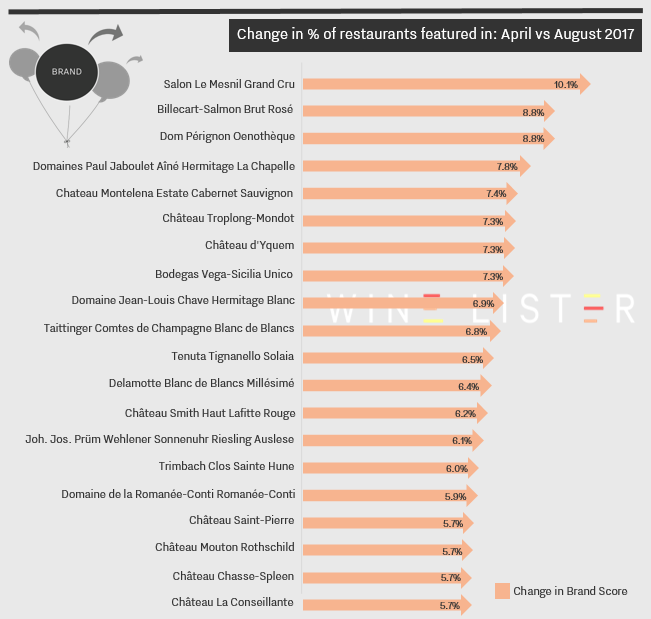
The top three wines are Champagnes: Salon Le Mesnil, Billecart-Salmon Brut Rosé, and Dom Pérignon Oenothèque (the last all the more impressive since the wine was re-branded a few years ago). None of them, however, is the wine with the largest restaurant presence. That accolade falls to Yquem, which saw its presence increase by 7.3% in the latest update, appearing on 69% of the world’s top wine lists – including Boulud in New York and Sketch in London.
Second most popular of the wines above is Mouton Rothschild, whose restaurant presence increased by 5.7%, and which overall features on 58% of the best restaurants, from The French Laundry in California to L’Atelier de Joël Robuchon in Hong Kong.
It is also interesting to note the wines that have relatively low overall restaurant presence but saw a significant increase in the latest update, suggesting that their stars are on the rise. These include Bordeaux Saint Pierre and Champagne Delamotte Blanc de Blancs Millésimé, which appeared on 2% of the previous restaurant lists but are now at 8% and 9% respectively. Meanwhile, Smith Haut Lafitte Rouge found its restaurant presence tip from 9% to 15% in the latest update.
This week’s Listed section focuses on the five Burgundy Grands Crus with the highest Quality scores. As previous analysis has shown, Burgundy’s greatest wines display better quality than those of any other major fine wine region. These five – all rare wines from some of the world’s most famous domaines – enjoy uniformly outstanding Quality scores. Unsurprisingly, they are also some of the most expensive wines in the world.
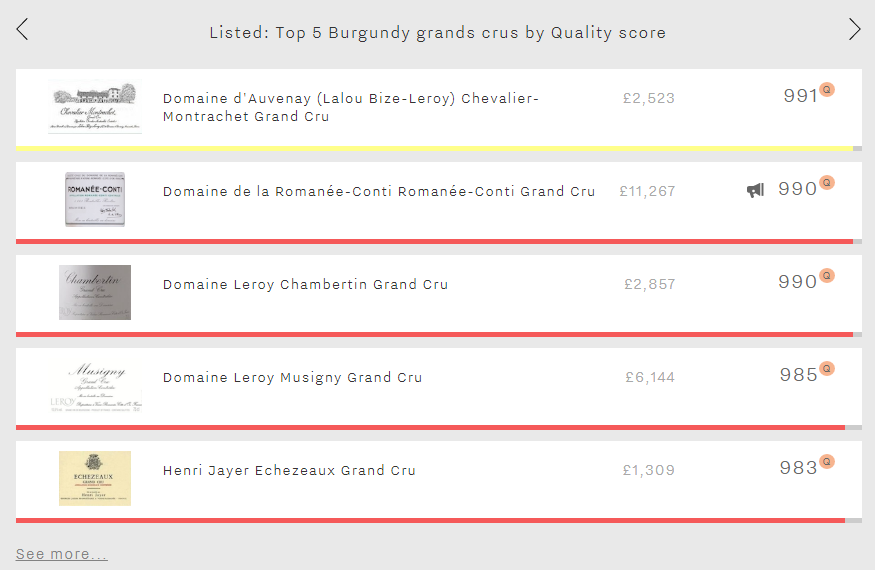
Leading the way is Domaine d’Auvenay Chevalier-Montrachet Grand Cru, the only white. The first of three wines in the top five overseen by Lalou Bize-Leroy, only 500 bottles of this rare wine leave the estate each year. Its wine level Quality score of 991 is the third-highest in Wine Lister’s database, behind two sweet Rieslings, while its average price per bottle of £2,523 is actually one of the more affordable in this list.
Moving up to the Côte de Nuits, next come Domaine de la Romanée-Conti Romanée-Conti Grand Cru and Domaine Leroy Chambertin Grand Cru, each with a Quality score of 990. Once again, low yields command high prices, with the former costing on average £11,267 per bottle. Proving that the reputations of two of the world’s most prominent fine wine producers are built upon firm foundations, these wines achieve the highest Quality scores of any red wine on Wine Lister.
The “Queen of Burgundy” continues her dominance with fourth-placed Domaine Leroy Musigny Grand Cru, which achieves a Quality score of 985 points. With Henri Jayer Echezeaux Grand Cru just two points behind, these Burgundy brands comprise four of the six top red wines for Quality Score on Wine Lister.